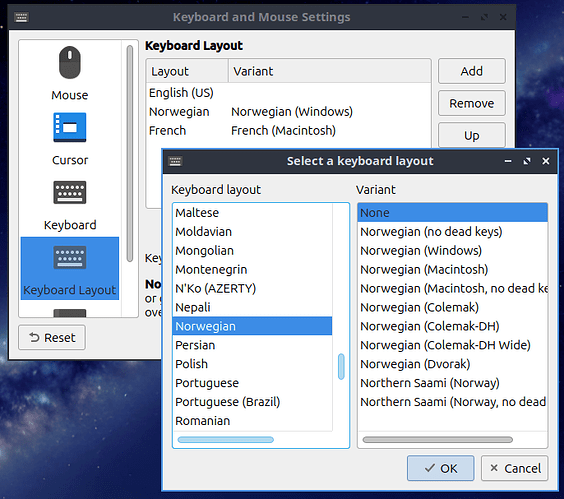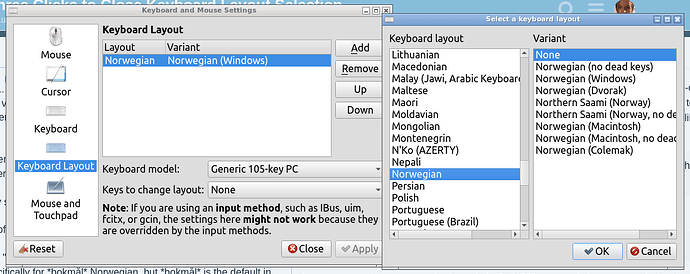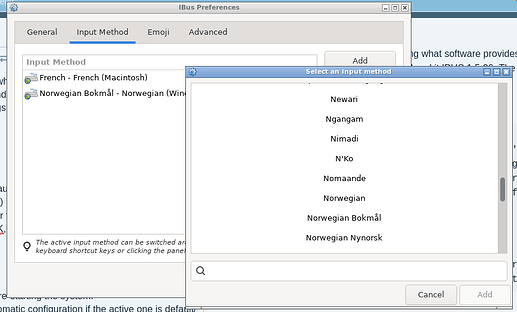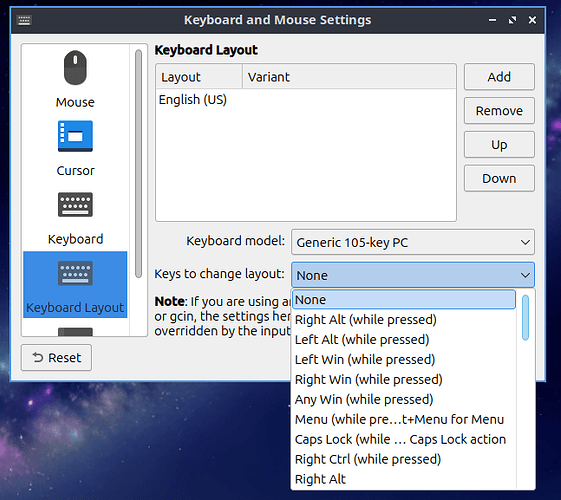Hi!
When switching between keyboard layouts in the task bar, closing the layout selection requires clicking three times. I could not find any info on this elsewhere on the internet or on this here forum.
Note that:
- Any additional clicks on the layout icon is another time I need to click the layout name in the menu in order to close it (i.e., if I click NB or FR in the video below twice, I need to select an option in the menu four times in order to close it, if I click NB or FR five times, I need to select an option seven times etc.)
- Selecting a different option each time doesn’t change the result.
Issue video
You can see in the video that I am clicking three times, as the menu moves left or right the two first times before the third click closes the menu.
Expected result:
Clicking once is enough to select a keyboard layout and close the menu.
Actual result:
Clicking once is enough to select a keyboard layout, but closing the menu requires at least 2 more clicks.
Environment details
Device: Unibody MacBook Pro
Lubuntu version: 22.04.4 LTS
Other hardware
H/W path Device Class Description
=================================================================
system MacBookPro6,2 (System SKU#)
/0 bus Mac-F22586C8
/0/0 processor Intel(R) Core(TM) i5 CPU M 520 @ 2.40GHz
/0/0/1 memory 3MiB L3 cache
/0/0/3 memory 256KiB L2 cache
/0/0/4 memory 32KiB L1 cache
/0/2 memory 32KiB L1 cache
/0/5 processor Pentium 4
/0/5/6 memory 3MiB L3 cache
/0/5/8 memory 256KiB L2 cache
/0/5/9 memory 32KiB L1 cache
/0/7 memory 32KiB L1 cache
/0/a processor Pentium 4
/0/a/b memory 3MiB L3 cache
/0/a/d memory 256KiB L2 cache
/0/a/e memory 32KiB L1 cache
/0/c memory 32KiB L1 cache
/0/f processor Pentium 4
/0/f/10 memory 3MiB L3 cache
/0/f/12 memory 256KiB L2 cache
/0/f/13 memory 32KiB L1 cache
/0/11 memory 32KiB L1 cache
/0/14 memory 8GiB System Memory
/0/14/0 memory 4GiB SODIMM DDR3 Synchronous 1067 MHz (0.9 ns)
/0/14/1 memory 4GiB SODIMM DDR3 Synchronous 1067 MHz (0.9 ns)
/0/1c memory 1MiB BIOS
/0/100 bridge Core Processor DRAM Controller
/0/100/1 bridge Core Processor PCI Express x16 Root Port
/0/100/1/0 /dev/fb0 display GT216M [GeForce GT 330M]
/0/100/1/0.1 card1 multimedia GT216 HDMI Audio Controller
/0/100/1/0.1/0 input17 input HDA NVidia HDMI/DP,pcm=3
/0/100/1/0.1/1 input18 input HDA NVidia HDMI/DP,pcm=7
/0/100/1/0.1/2 input19 input HDA NVidia HDMI/DP,pcm=8
/0/100/1/0.1/3 input20 input HDA NVidia HDMI/DP,pcm=9
/0/100/2 /dev/fb1 display Core Processor Integrated Graphics Controller
/0/100/1a bus 5 Series/3400 Series Chipset USB Universal Host Controller
/0/100/1a.7 bus 5 Series/3400 Series Chipset USB2 Enhanced Host Controller
/0/100/1a.7/1 usb2 bus EHCI Host Controller
/0/100/1a.7/1/1 bus USB 2.0 Hub
/0/100/1a.7/1/1/1 bus BRCM2070 Hub
/0/100/1a.7/1/1/1/3 communication Bluetooth USB Host Controller
/0/100/1a.7/1/1/2 input10 input bcm5974
/0/100/1a.7/1/1/3 scsi0 storage Card Reader
/0/100/1a.7/1/1/3/0.0.0 /dev/sdb disk SD Card Reader
/0/100/1a.7/1/1/3/0.0.0/0 /dev/sdb disk
/0/100/1a.7/1/1/4 input8 input PixArt HP USB Optical Mouse
/0/100/1b card0 multimedia 5 Series/3400 Series Chipset High Definition Audio
/0/100/1b/0 input14 input HDA Intel MID Line
/0/100/1b/1 input15 input HDA Intel MID Headphone
/0/100/1b/2 input16 input HDA Intel MID SPDIF In
/0/100/1c bridge 5 Series/3400 Series Chipset PCI Express Root Port 1
/0/100/1c/0 enp2s0 network NetXtreme BCM5764M Gigabit Ethernet PCIe
/0/100/1c.1 bridge 5 Series/3400 Series Chipset PCI Express Root Port 2
/0/100/1c.1/0 wlp3s0 network BCM43224 802.11a/b/g/n
/0/100/1c.2 bridge 5 Series/3400 Series Chipset PCI Express Root Port 3
/0/100/1c.2/0 bus FW643 [TrueFire] PCIe 1394b Controller
/0/100/1c.3 bridge 5 Series/3400 Series Chipset PCI Express Root Port 4
/0/100/1d bus 5 Series/3400 Series Chipset USB Universal Host Controller
/0/100/1d.7 bus 5 Series/3400 Series Chipset USB2 Enhanced Host Controller
/0/100/1d.7/1 usb1 bus EHCI Host Controller
/0/100/1d.7/1/1 bus USB 2.0 Hub
/0/100/1d.7/1/1/1 multimedia Built-in iSight
/0/100/1d.7/1/1/2 input11 input Apple Computer, Inc. IR Receiver
/0/100/1d.7/1/1/3 input4 input Logitech USB Keyboard System Control
/0/100/1e bridge 82801 Mobile PCI Bridge
/0/100/1f bridge HM55 Chipset LPC Interface Controller
/0/100/1f/0 system PnP device PNP0103
/0/100/1f/1 system PnP device PNP0c02
/0/100/1f/2 system PnP device PNP0c02
/0/100/1f/3 system PnP device PNP0b00
/0/100/1f/4 generic PnP device APP000b
/0/100/1f/5 system PnP device PNP0c02
/0/100/1f.2 scsi1 storage 5 Series/3400 Series Chipset 4 port SATA AHCI Controller
/0/100/1f.2/0 /dev/sda disk 500GB Samsung SSD 850
/0/100/1f.2/0/1 volume 200MiB EFI GPT partition
/0/100/1f.2/0/2 /dev/sda2 volume 184GiB Darwin/OS X HFS+ partition
/0/100/1f.2/0/3 /dev/sda3 volume 280GiB EXT4 volume
/0/100/1f.2/1 /dev/cdrom disk DVD-R UJ-898
/0/100/1f.3 bus 5 Series/3400 Series Chipset SMBus Controller
/0/100/1f.6 generic 5 Series/3400 Series Chipset Thermal Subsystem
/0/101 bridge Core Processor QuickPath Architecture Generic Non-core Register
/0/102 bridge Core Processor QuickPath Architecture System Address Decoder
/0/103 bridge Core Processor QPI Link 0
/0/104 bridge 1st Generation Core i3/5/7 Processor QPI Physical 0
/0/105 bridge 1st Generation Core i3/5/7 Processor Reserved
/0/106 bridge 1st Generation Core i3/5/7 Processor Reserved
/1 power Unknown
/2 input0 input Lid Switch
/3 input1 input Power Button
/4 input12 input Video Bus
/5 input2 input Sleep Button
/6 input21 input applesmc
/7 input3 input Power Button





